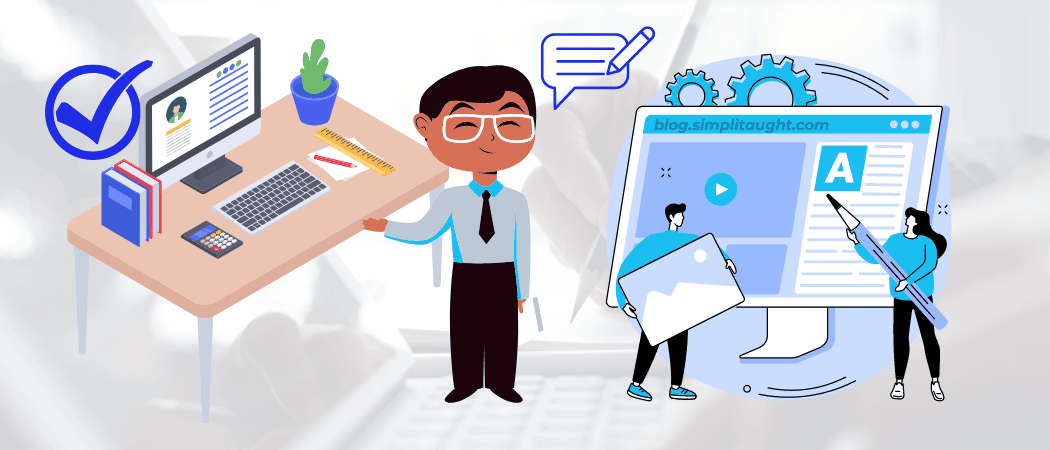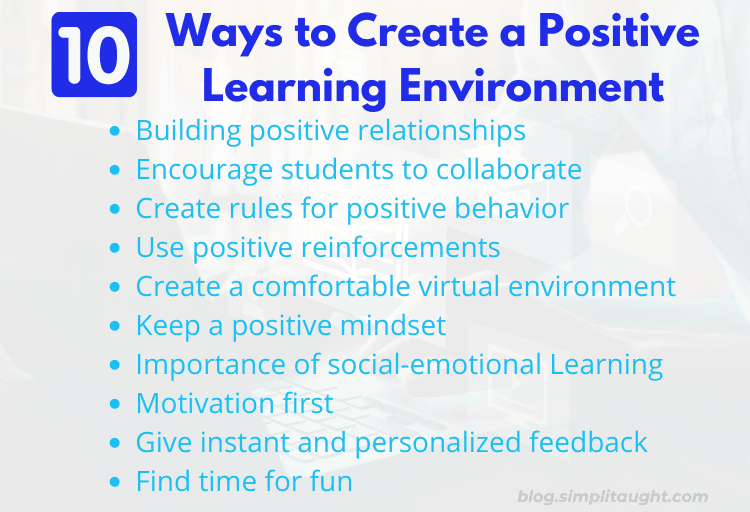A positive learning environment is much more than motivating posters on the wall in the learning center. And as the world has moved to remote learning after the pandemic, teachers must truly understand and support the students’ needs to create an environment for learning that celebrates diversity.
For instance, clearly establishing classroom rules will help set the tone for a healthy learning environment, where learners know what is expected. Students feel confident, comfortable, and booming when they fulfill these expectations. Having such structures in place will aid students to feel safe, allow teachers to understand their needs, and promote positive well-being.
Negative vs. Positive Classroom Environment
Educators also need to keep in mind that creating an environment for learning isn’t a one-time thing but requires renewed attention every time. For such attention to detail, they must understand the difference between negative and positive learning environments.
Impact of a Positive Learning Environment
To dig deep into the differences between negative and positive learning environments, let’s first look into what a positive learning space feels like to students.
Sense of Security
Learners feel safe coming to school or joining virtual classrooms without the feeling that they must act a certain way for acceptance.
Take Risks
When they feel safe in the environment, students are more likely and willing to take risks in their learning process without fearing failure. After all, we learn best when we fail.
Sense of Community
A positive environment in classrooms and online instills a sense of community among students and staff members. As a result, they are more excited and willing to engage and interact with each other.
Impact of Negative Learning Environment
However, in a negative learning environment, students experience more undesirable feelings such as;
Feeling Frustrated
Higher frustration levels in students are likely to lead to more disciplinary rates. On the contrary, the educational staff can contain this issue by employing clear classroom management strategies.
Disconnect
A negative learning environment results in a disconnect between students and their teachers. A sense of community is lost, and the learning process becomes passive due to lesser interaction and lack of active participation in classroom activities.
Stress
Students and educators can also feel stressed, leading to burnout and anxiety. Therefore, institutions should have self-care techniques in practice to help them de-stress.
Thus, the creation of a positive learning environment becomes crucial.
Why is a Positive Learning Environment Critical?
Preparing a framework for a positive online learning space requires a lot of thought and consideration. But once the system is in place, both students and teachers reap the benefits of the hard work. For example,
- Research evidence suggests that such environments in place increase academic performance.
- Students with disabilities will find more significant support from fellow learners.
- There will be enhanced opportunities for interaction among students, teachers, and parents/guardians.
- Different stakeholders will appreciate that students’ and teachers’ mental health is taken as seriously as their achievements.
- This way, students take ownership of their learning experience, making informed efforts to improve their grades and performance (also known as self-regulated learning).
You can create an environment conducive to students’ development from the get-go to help them achieve their academic goals.
10 Ways to Create a Positive Learning Environment
Here are the critical components of creating a healthy environment for students to excel.
1. Building Positive Relationships
Creating positive relationships with students and parents is vital; it begins when students join the virtual classroom.
Knowing your students’ unique personalities, needs, likes, dislikes, strengths, and areas where they can improve is essential to building such relationships. Educators will be able to support students both individually and collectively if they put in the work early.
One approach to building rapport with students is to greet them every time they join the classroom. Such gestures show that you care about them and see what they are doing.
Also, to build a good relationship with parents, take out time to communicate with them about the qualities you see in their children. For example, sending a quick note about the student’s success in class can go a long way as it shows that you notice the great things they are doing. It also helps parents or guardians feel like they are part of the kids’ education.
2. Encourage Students to Collaborate
There are plenty of ways to help foster strong student connections. Consequently, it will help improve students’ sense of belonging, create a caring positive classroom environment, and increase engagement.
Educators can use these two strategies to help students with it. First, provide a space where students can collaborate before class and discuss things they are passionate about. Then listen to what they have to say. It will forge a strong bond between students and teachers. For example, if you learn that one of your students loves ballet, try asking them about it next time they are online in the class.
Moreover, teachers must implement highly personalized lessons to help students feel special and seen.
3. Create Rules for Positive Behavior
High expectations from learners are vital for setting the norms for student behaviors and laying the foundation for their success. For this purpose, set clear classroom rules and techniques.
One excellent way to implement these rules is to frame them positively. For instance, instead of saying “don’t disrespect any student,” try framing it like “all students should be respectful to each other at all times.” This positive framing will make a huge difference as you show that the expectation is tied to positive behavior.
4. Use Positive Reinforcements
Positive reinforcement helps build intrinsic motivation and promotes positive learning habits. The two techniques that teachers can use are;
Recognize when students are making an effort to excel, even if they don’t display a hundred percent mastery. Sometimes, we learn best when we are failing. So praise their efforts to persevere, which will help them, in the long run, to not give up in the face of challenges and implement problem-solving methods.
Additionally, take the time to celebrate the smallest wins of the students who are usually reluctant to participate. Appreciating their job well goes a long way in building trust and helping students feel seen and heard. As a result, it will increase the likelihood that they repeat this behavior.
5. Create a Comfortable Virtual Environment
It may be impossible to high-five kids on their way to a virtual space, but there are other ways teachers can give personality to the virtual environment. They can make the atmosphere feel real and bring a sense of togetherness by;
First, begin the class with a greeting and ensure that all students see your face. Although it may seem trivial, it adds a personal touch that lets learners feel good about attending the lesson.
Then, ask a question before jumping into the lesson’s content. A fun icebreaker can get learners to talk and interact before starting the learning process. Teachers can get help from VR and AR for a better virtual environment.
Moreover, having a simple yet engaging background can be game-changing. Teachers should put up relevant class posters, fun decor, and inspirational sayings. Showing your personality to learners in your video background will let them know you better as their instructor.
6. Keep a Positive Mindset
Anyone who has been an educator knows how exhausting this job can be. So, taking time for yourself becomes very important. Online education has its own pros and cons which everyone should have to know. While it is challenging with the demands both inside and outside of the classroom, it is highly recommended that you work to find some time for yourself to implement self-care techniques to help you maintain a positive mindset.
7. Importance of Social-Emotional Learning
Students and teachers’ well-being has taken the forefront for good reasons. Perhaps it is easier said than done, but the mental health of students and teachers is critical.
Social-emotional learning (SEL) helps students understand their emotions and regulate them in an uncertain world. Teachers can implement these SEL strategies using several ways. For example, having mindfulness activities will help students to learn and navigate new emotions and aid them in bringing their better selves to the classroom, contributing positively to the educational environment.
8. Motivation First
Creating lessons and unit plans while keeping motivation in mind sparks excitement and joy in the learning process.
Teachers must weave topics that learners are passionate about and try to find ways to make otherwise dull lessons more interactive and fun.
Integrating game-based activities with the learning process can help students have fun and enjoy the educational experience.
9. Give Instant and Personalized Feedback
Showing students that you care about their academic performance and effort can help to motivate them and foster positive learning outcomes. A pro tip for this would be to personalize feedback for students, as it’s a great way to take some time out and highlight the achievements of the students and the areas they need to improve on.
For instance, learners have completed a short writing assignment. You correct the mistakes in it and have left some notes in the margin. But to take it one step further, leave a personalized note on the top corner of the assignment and use their name. Highlight the things they aced in the assignment and the areas for improvement. Leaving a personalized note will increase the chances that they will internalize the feedback you’ve given them.
10. Find Time for Fun
Solely focusing on academic material can lead to burnout. Instead, educators should be aware of incorporating games into learning and naturally weaving fun into lessons that students will appreciate. These things will make distance learning more fun and fruitful.
It’s fulfilling to hear students laugh while having fun and working together to learn, ultimately leading to a positive learning environment.
Final Thoughts!
A positive learning environment in your virtual classrooms will set your students up for success. Educators will set a stage for students to love online learning.











